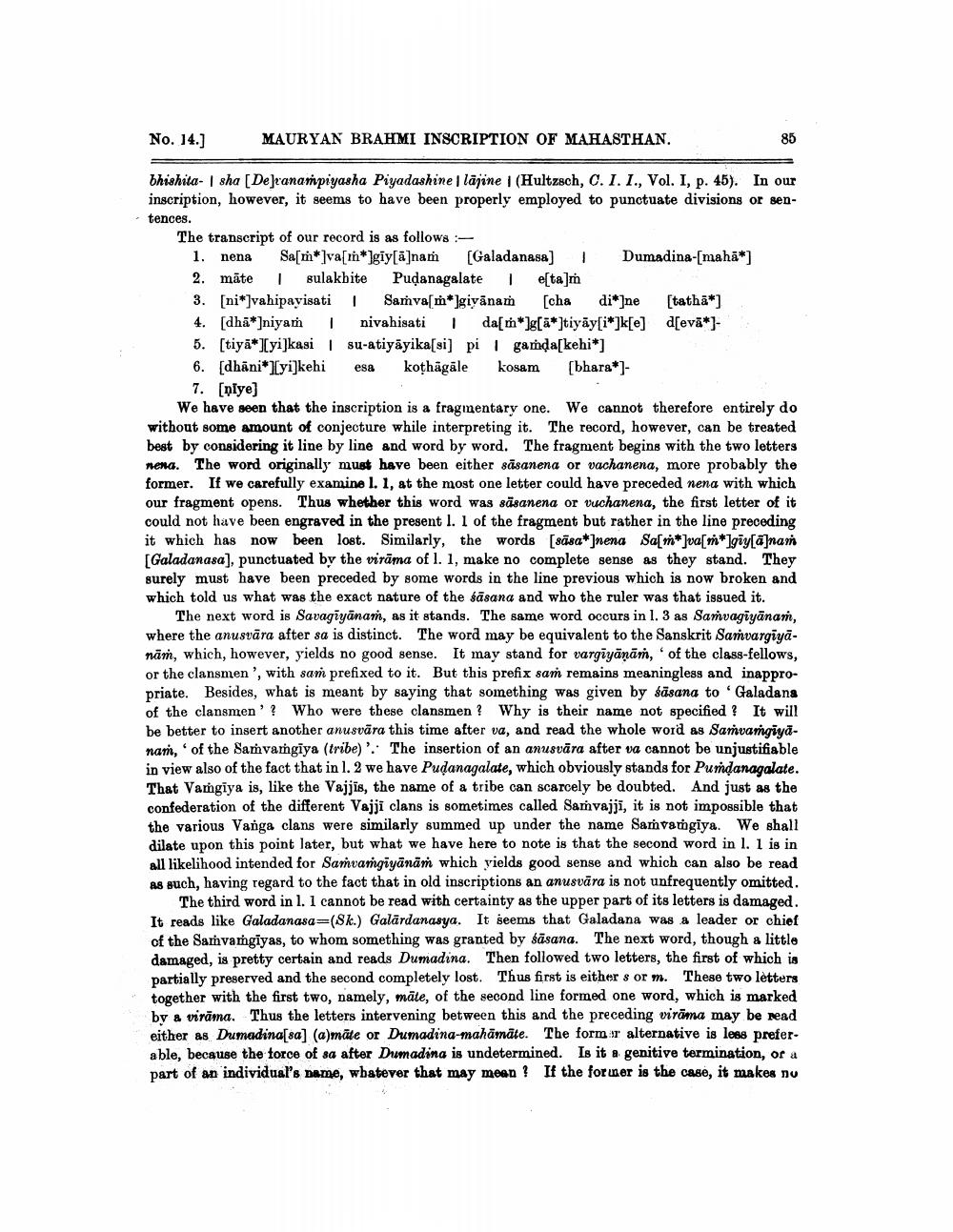________________
No. 14.]
MAURYAN BRAHMI INSCRIPTION OF MAHASTHAN.
85
bhishita- | sha [Deranaṁpiyasha Piyadashine lājine (Hultzsch, C.I.I., Vol. I, p. 45). In our inscription, however, it seems to have been properly employed to punctuate divisions or sentences.
The transcript of our record is as follows:
1. nena Sa[m*]va[un*]giy[ā]nam (Galadanasa] Dumadina-[mahā*] 2. māte 1 Bulakbite Pudanagalatel eta] 3. [ni*]vahipavisati i Saṁva[m*]givānam [cha di*]ne (tathā*] 4. [dhā*]niyam i nivahisati i da[m*]g[ā*]tiyāy[i*]k[e] d[evā*). 5. [tiyā*Iyi]kasi su-atiyāyika[si] pi l gamda[kehi*] 6. [dhāni*Iyi]kehi esa kothāgāle kosam [bhara*]
7. [niye) We have seen that the inscription is a fragmentary one. We cannot therefore entirely do without some amount of conjecture while interpreting it. The record, however, can be treated best by considering it line by line and word by word. The fragment begins with the two letters nena. The word originally must have been either säsanena or vachanena, more probably the former. If we carefully examine l. 1, at the most one letter could have preceded nena with which our fragment opens. Thus whether this word was säsanena or vuchanena, the first letter of it could not have been engraved in the present I. l of the fragment but rather in the line preceding it which has now been lost. Similarly, the words [sāsa*]nena Sa[*]va[*]giy[a]nan Galadanasal, punctuated by the virāma of l. 1, make no complete sense as they stand. They surely must have been preceded by some words in the line previous which is now broken and which told us what was the exact nature of the sāsana and who the ruler was that issued it.
The next word is Savagīyānań, as it stands. The same word occurs in I. 3 as Samvagiyānam, where the anusvāra after sa is distinct. The word may be equivalent to the Sanskrit Samvargiyanām, which, however, yields no good sense. It may stand for vargiyānāṁ, of the class-fellows, or the clansmen', with sam prefixed to it. But this prefix sam remains meaningless and inappropriate. Besides, what is meant by saying that something was given by säsana to 'Galadana of the clansmen'? Who were these clansmen? Why is their name not specified ? It will be better to insert another anusvāra this time after va, and read the whole word as Samvargiyanan, of the Saṁvargiya (tribe). The insertion of an anusvära after va cannot be unjustifiable in view also of the fact that in l. 2 we have Pudanagalate, which obviously stands for Pundanagalate. That Vangiya is, like the Vajjīs, the name of a tribe can scarcely be doubted. And just as the confederation of the different Vajji clans is sometimes called Samvajji, it is not impossible that the various Vanga clans were similarly summed up under the name Samvargiya. We shall dilate upon this point later, but what we have here to note is that the second word in l. 1 is in all likelihood intended for Samvangiyānāṁ which yields good sense and which can also be read As such, having regard to the fact that in old inscriptions an anusvāra is not unfrequently omitted.
The third word in l. 1 cannot be read with certainty as the upper part of its letters is damaged. It reads like Galadanasa=(Sk.) Galārdanasya. It seems that Galadana was a leader or chief of the Sarvamgiyas, to whom something was granted by sāsana. The next word, though a little damaged, is pretty certain and reads Dumadina. Then followed two letters, the first of which is partially preserved and the second completely lost. Thus first is either s orm. These two letters together with the first two, namely, māte, of the second line formed one word, which is marked by & virāma. Thus the letters intervening between this and the preceding virāma may be read either as Dumadina[sa] (a)māte or Dumadina-mahāmāte. The form r alternative is less preferable, because the force of sa after Dumadina is undetermined. Is it a genitive termination, or a part of an individual's name, wbatever that may mean? If the former is the case, it makes no




